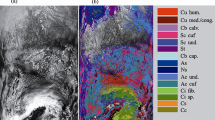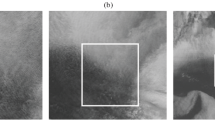Abstract
Modifications of algorithms for the classification of single-layer, vertical development clouds, and multilayer clouds based on a probabilistic neural network and a neuro-fuzzy classifier are proposed. Clouds are classified into 16 types according to the meteorological standard, including the combined subtypes of stratus, altocumulus, cirrus, and cirrostratus clouds. The article uses a description of clouds based on information about the texture of their images on satellite images from MODIS and its products with data on the physical parameters of clouds. The structure of classification algorithms is described. The results of the use of statistical models of image texture and physical parameters of clouds for initializing membership functions for a neural-fuzzy classifier are presented. Systems of effective classification characteristics for different classification algorithms are formed based on the GRAD modified truncated search method. The recognition results of single-layer, vertical development clouds, and multilayer clouds based on the corresponding test samples and full-size sets of MODIS satellite data with different spatial resolution are discussed.


Similar content being viewed by others
REFERENCES
Abramowitz, M. and Stegun, I., Handbook of Mathematical Functions with Formulas, Graphs, and Mathematical Tables, New York: Dover, 1972; Moscow: Nauka, 1979.
Astafurov, V.G. and Skorokhodov, A.V., Classification of multitier cloudiness according to MODIS data using the neural networks technology and fuzzy logic methods, Sovrem. Probl. Distantsionnogo Zondirovaniya Zemli Kosmosa, 2015, vol. T. 12, no. 6, pp. 162–173.
Astafurov, V.G. and Skorokhodov, A.V., Formation of a system of informative classification characteristics for classification of clouds from MODIS satellite data, Tr. SPIIRAN, 2017a, vol. T. 53, no. 4, pp. 118–139.
Astafurov, V.G. and Skorokhodov, A.V., Statistical model of physical parameters of cloudiness from MODIS thematic products, Issled. Zemli Kosmosa, 2017b, no. 5, pp. 66–81.
Astafurov, V.G., Kuriyanovich, K.V., and Skorokhodov, A.V., Methods for automatic cloud classification from MODIS data, Izv., Atmos. Ocean. Phys., 2016, vol. 52, no. 9, pp. 1110–1119.
Astafurov, V.G., Kuriyanovich, K.V., and Skorokho-dov, A.V.A., Statistical model for describing the texture of cloud cover images from satellite data, Russ. Meteorol. Hydrol., 2017, vol. 42, no. 4, pp. 248–257.
Bankert, R.L., Mitrescu, C., Miller, S.W., and Wade, R.H., Comparison of GOES cloud classification algorithms employing explicit and implicit physics, J. Appl. Meteorol. Climatol., 2009, vol. 48, pp. 1411–1421.
Baum, B.A., Tovinkere, V., Titlow, J., and Welch, R.M., Automated cloud classification of global AVHRR data using a fuzzy logic approach, J. Appl. Meteorol., 1997, vol. 36, pp. 1519–1540.
Bespalov, D.P., Devyatkin, A.M., Dovgalyuk, Yu.A., Kondratyuk, V.I., Kuleshov, Yu.V., Svetlova, T.P., Suvorov, S.S., and Timofeev, V.I., Atlas oblakov (Atlas of Clouds), St. Petersburg: D’ART, 2011.
Bondur, V.G. and Arzhenenko, N.I., Classification of cloud forms by the spatial spectrum of images, Opt. Atmos. Okeana, 1988, no. 11, pp. 38–45.
Boreskov, A.V. and Kharlamov, A.A., Osnovy raboty s tekhnologiei CUDA (Basics of Working with the CUDA Technology), Moscow: DMK, 2010.
Davis, S.M., Landgrebe, D.A., Phillips, T.L., Swain, P.H., Hoffer, R.M., Lindenlaub, J.C., and Silva, L.F., Remote Sensing: The Quantitative Approach, New York: McGraw-Hill, 1978; Moscow: Nedra, 1983.
Federal’naya sluzhba po gidrometeorologii i monitoringu okruzhayushchei sredy (Rosgidromet). Kod dlya operativnoi peredachi dannykh prizemnykh meteorologicheskikh nablyudenii s seti stantsii Rosgidrometa (Federal Service for Hydrometeorology and Environmental Monitoring (Roshydromet). Code for the Operational Transmission of Surface Meteorological Observations from the Roshydromet Network), Moscow: Triada, 2013.
Haralick, R.M., Shanmugam, K., and Dinstein, I., Textural features for image classification, IEEE Trans. Syst. Man Cybern., 1973, vol. SMC-3, no. 6, pp. 610–621.
Jin, W., Gong, F., Zeng, X., and Fu, R., Classification of clouds in satellite imagery using adaptive fuzzy sparse representation, Sensors, 2016, vol. 16. https://doi.org/10.3390/s16122153
Kobzar’, A.I., Prikladnaya matematicheskaya statistika: dlya inzhenerov i nauchnykh rabotnikov (Applied Mathematical Statistics for Engineers and Scientists), Moscow: Fizmatlit, 2006.
Kolodnikova, N.V., Survey of textural characteristics for pattern recognition problems, Dokl. Tomsk.Gos. Univ. Sist. Upr. Radioelektron., 2004, vol. 9, no. 1, pp. 113–124.
Kruglov, V.V., Dli, M.I., and Golunov, R.Yu., Nechetkaya logika i iskusstvennye neironnye seti (Fuzzy Logic and Artificial Neural Networks), Moscow: Fizmatlit, 2001.
Liu, Y., Xia, J., Shi, C.-X., and Hong, Y., An improved cloud classification algorithm for China’s FY-2C multi-channel images using artificial neural network, Sensors, 2009, vol. 9, pp. 5558–5579.
Menzel, W.E., Frey, R.A., and Baum, B.A., Cloud Top Properties and Cloud Phase, (Algorithm Theoretical Basis Document, Collection 006 Update), Greenbelt, Maryland: Goddard Space Flight Center, 2013.
MODIS (Moderate Resolution Imaging Spectroradiometer) 2000–2017. https://modis.gsfc.nasa.gov/about/specifications.php. Accessed August 30, 2017.
Osowski, S., Sieci neuronowe do przetwarzania informacji, Warszawa: Oficyna Wydawnicza Politechniki Warszawskiej, 2000; Moscow: Finansy i statistika, 2002.
Shakina, N.P., Lektsii po dinamicheskoi meteorologii (Lectures on Dynamic Meteorology), Moscow: Triada, 2013.
Skorokhodov, A.V., Aksenov, S.V., Aksenov, A.V., and Laikom, D.N., Different computer systems for automatic classification of clouds from MODIS satellite data on the basis of a probabilistic neural network), Izv. Tomsk.Politekh. Univ., 2016, vol. 327, no. 1, pp. 30–39.
Specht, D.F., Probabilistic neural networks, Neural Networks, 1990, vol. 3, pp. 109–118.
Suzue, H., Imai, T., and Mouri, K., High-resolution cloud analysis information derived from Himawari-8 data, Meteorol. Satell. Center Tech. Note, 2016, no. 61, pp. 43–51.
Tapakis, R. and Charalambides, A.G., Equipment and methodologies for cloud detection and classification: A review, Sol. Energy, 2013, vol. 95, pp. 392–430.
Unser, M., Sum and difference histograms for texture classification, IEEE Trans. Syst.,Pattern Anal. Machine Intell., 1986, vol. PAMI-8, no. 1, pp. 118–125.
Volkova, E.V. and Uspenskii, A.B., Estimates for the parameters of cloud cover according to the data of the METEOSAT-9 geostationary satellite around the clock in automatic mode, Sovrem. Probl. Distantsionnogo Zondirovaniya Zemli Kosmosa, 2010, vol. 7, no. 3, pp. 65–73.
Weszka, J.S., Dyer, C.R., and Rosenfeld, A., A comparative study of texture measures for terrain classification, IEEE Trans. Syst. Man Cybern., 1976, vol. SMC-6, no. 4, pp. 269–285.
Zagoruiko, N.G., Kognitivnyi analiz dannykh (Cognitive Data Analysis), Novosibirsk: GEO, 2013.
Funding
This work was supported by the Russian Foundation for Basic Research, project no. 16-37-60019mol_a_dk.
Author information
Authors and Affiliations
Corresponding author
Additional information
Translated by O. Pismenov
Rights and permissions
About this article
Cite this article
Skorokhodov, A.V., Astafurov, V.G. & Evsutkin, T.V. Application of Statistical Models of Image Texture and Physical Parameters of Clouds for Their Classification on MODIS Satellite Images. Izv. Atmos. Ocean. Phys. 55, 1053–1064 (2019). https://doi.org/10.1134/S0001433819090482
Received:
Published:
Issue Date:
DOI: https://doi.org/10.1134/S0001433819090482




